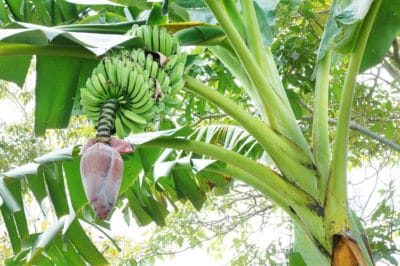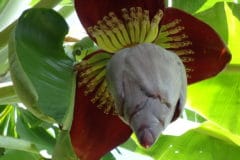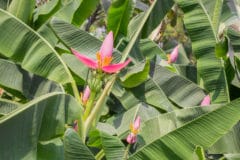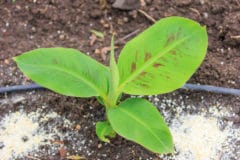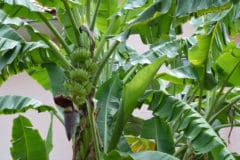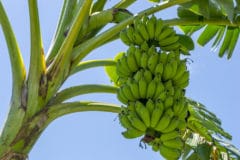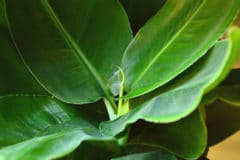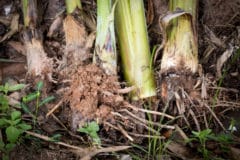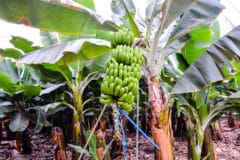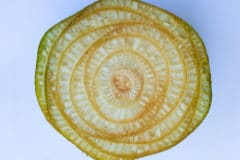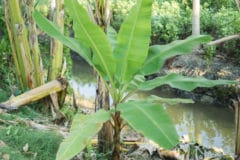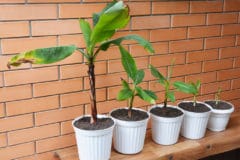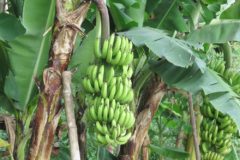What Are Bananas?
The banana is a member of the same family – Zingiberales – as ginger and the bird of paradise flower. Named for an ancient Roman physician, Antonia Musa, this perennial shrub grows from underground rhizomes. In the right conditions, a banana plant bears a single flower stalk that flowers, fruits and dies. In non-tropical settings, some plants flower but may not actually set any fruit.
How Do Bananas Grow?
The banana plant grows from a rhizomatous mass, similar to that of an iris. Fleshy stalks known as pseudostems form upright concentric layers of leaf sheaths. These look like trunks, earning the name banana tree, but the true stem comes from an underground corm and grows in the center of the plant. This stem appears over a year after planting and bears the flowers and fruit.
What Varieties Can I Choose?
Unless you live in the tropics, bananas are more likely to be an ornamental plant in your garden or greenhouse. These are available:
- Musa acuminata ‘Lakatan’ – a popular dessert banana in the Philippines.
- Musa paradisiaca – French plantain, grown in USDA Zones 9-11; edible.
- Musa acuminata ‘Dwarf Cavendish’ – a commercially important banana.
- Musa ‘Praying Hands’ – fruits are fused together, giving rise to the name; a small plant.
Can I Grow Bananas to Eat?
The answer to this question is a qualified “maybe.” Some edible bananas can be grown in warmer regions of Florida, Texas and California, or desert states like Arizona. Plantains, served cooked, grow in the southern US. Most of these areas are USDA zones 9 to 11. Commercial varieties like the Cavendish – the common grocery store banana – grow in the tropics only.
What Soil Do I Use for Bananas?
Bananas need a rich but well-drained soil. Soil similar to that in Hawaii – with some small rocks and lava sand – promotes the excellent drainage these plants require. Well-rotted manure, leaf mold or organic compost add humus and the important nutrients. Commercial cactus mix plus humus or compost is a good choice, or add 2/3 of this mix to 1/3 native soil.
How Do I Water Bananas?
A banana likes plenty of water and will not tolerate drought. However, wet soil increases the risk of root rot. In summer, a banana plant – especially if outside or in a container – may need water at least every other day. In winter, when plants are semi-dormant, you may only need to water once a week or less. Check the soil daily – it should be evenly moist.
How Do I Protect Bananas Grown Outside?
Some ornamental banana varieties can grow in cold areas – USDA Zones 4 and above – although the leaves will typically burn with even a slight frost. The top of the plant may appear dead, but when the weather warms, they will grow new leaves. Plant in sheltered locations, mulch heavily and cover with blankets or other frost protection at night.
How Do I Fertilize Bananas?
The banana is a heavy feeder and benefits from regular applications of fertilizer. Using a dilute application of liquid organic fertilizer every time you water is the first choice. You can also apply a small amount of balanced organic fertilizers in powdered or granular form once a month. Decrease nitrogen once flowers appear or the fruit may turn black.
What Kind of Sun Does a Banana Plant Need?
Bananas prefer the kind of bright indirect light found in the forest understory. However, they are susceptible to sunburn. Hot afternoon sun may scorch leaves. If you live in a hot area, give your bananas full sun in the morning with some partial shade in the afternoon. Don’t try to grow them in shady areas – they will be more susceptible to disease and will not flower well.
Can I Grow Bananas in Containers?
Bananas can make good container plants if the pot is large enough. For a standard size banana, you’ll need a minimum of a 15-gallon pot. In the wild, bananas grow in small groups, which helps protect them from wind and heavy rains. Ideally, grow at least three in a group. Smaller ornamental Musa plants may only grow 24 inches tall and can be grown in smaller pots.
